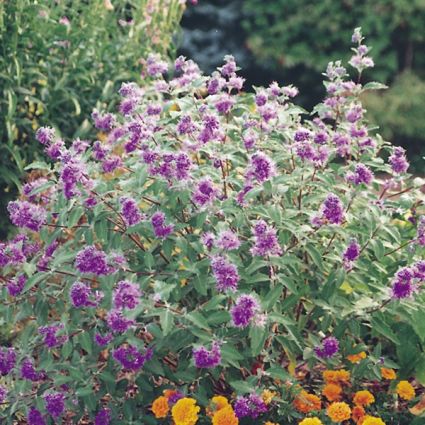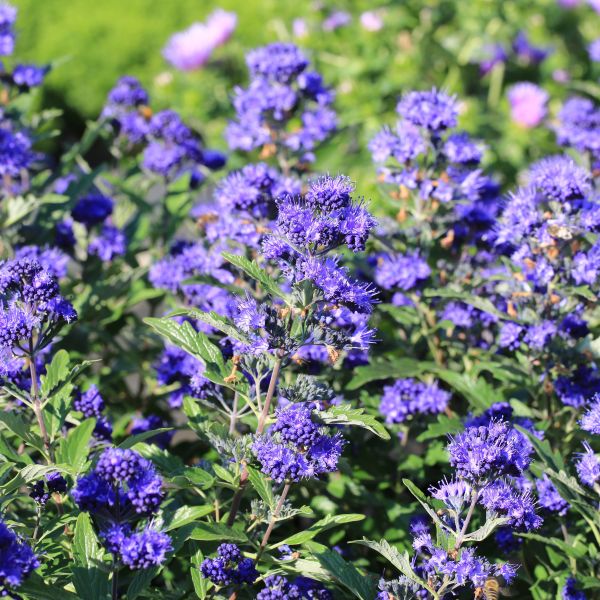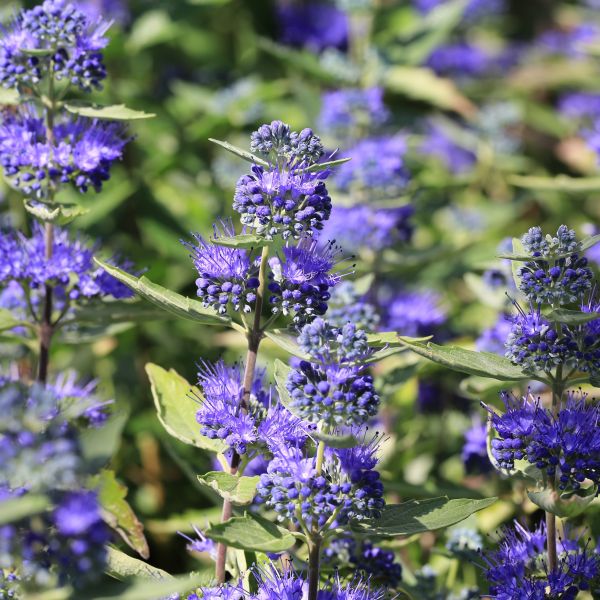


Arthur J. Simmonds Bluebeard
Caryopteris x clandonensis 'Arthur J. Simmonds'
78 reviews
Arthur J. Simmonds Bluebeard
Caryopteris x clandonensis 'Arthur J. Simmonds'
78 reviews
1 Gallon
We are sorry, product is currently out of stock due to seasonal availability. Please check the "Related plants available in your area" section below
Not just beautiful - intentionally selected by ShrubHub's 3D landscape design team to fit real-world spaces and maximize yard potential.
Why Arthur J. Simmonds Bluebeard?
Arthur J. Simmonds Bluebeard (Caryopteris x clandonensis 'Arthur J. Simmonds') is a popular shrub that is known for its stunning blue flowers. This cultivar exhibits beautiful silver-gray foliage that contrasts well with the vibrant blue blooms. It is a compact and versatile plant, reaching a height of around 2-3 feet. Arthur J. Simmonds Bluebeard is a favorite among gardeners for its attractive appearance and ability to attract bees and butterflies.
Sunlight
The Arthur J. Simmonds Bluebeard plant requires full sun exposure, meaning it needs at least 6 hours of direct sunlight each day to thrive.
Watering
The watering requirement for Arthur J. Simmonds Bluebeard plant is moderate.
Fertilizing
Arthur J. Simmonds Bluebeard requires a balanced fertilizer with a ratio of nitrogen (N), phosphorus (P), and potassium (K) in the ratio of 10-10-10.
The Arthur J. Simmonds Bluebeard (Caryopteris x clandonensis 'Arthur J. Simmonds') is a stunning perennial shrub that will add beauty and interest to any garden or landscape. It is a member of the mint family and is known for its compact growth habit and gorgeous blue flowers.
This variety of Bluebeard is named after Arthur J. Simmonds, a renowned horticulturist who dedicated his life to breeding and introducing new plant varieties. The Arthur J. Simmonds Bluebeard is one of his most successful creations.
The foliage of this shrub is a standout feature. The green leaves are small and lance-shaped, with a slightly serrated edge. They are fragrant and release a pleasant scent when touched or brushed against, making this plant a sensory delight.
From late summer to early fall, the Arthur J. Simmonds Bluebeard bursts into bloom. Vibrant clusters of small, tubular blue flowers cover the shrub, creating a striking display. The flowers attract butterflies, bees, and other pollinators, adding life and movement to your garden.
This Bluebeard shrub is relatively compact, reaching a mature height of around 2 to 3 feet. Its neat and tidy growth habit makes it an excellent choice for smaller gardens, front yard plantings, or as a border plant. It can also be grown in containers or used for mass plantings to create a sea of blue.
Care for the Arthur J. Simmonds Bluebeard is relatively easy. It prefers full sun but can tolerate some light shade. Well-drained soil is essential for its health and longevity. Once established, it is reasonably drought-tolerant, making it a suitable choice for dry or low-water landscaping.
Pruning this shrub is recommended in late winter or early spring to promote new growth and maintain its compact shape. The spent flower clusters can also be removed to encourage continuous blooming.
Overall, the Arthur J. Simmonds Bluebeard is a must-have plant for any garden enthusiast or landscape designer. With its beautiful blue flowers, fragrant foliage, and ease of care, it will surely become a highlight of your outdoor space.
Plant Information:
| Botanical Name: | Caryopteris x clandonensis 'Arthur J. Simmonds' |
| USDA Zones: | 5 - 9 |
| Water: | Moderate |
| Exposure: | Full Sun |
| Soil Needs: | Widely Adaptable |
| Mature Height: | 1 to 2 feet |
| Mature Spread: | 2 to 3 feet |






Pollination Info
Pollination Information for Arthur J. Simmonds Bluebeard (Caryopteris x clandonensis 'Arthur J. Simmonds')
Arthur J. Simmonds Bluebeard, scientifically known as Caryopteris x clandonensis 'Arthur J. Simmonds', is a deciduous, woody shrub that belongs to the Verbenaceae family. It is known for its vibrant blue flowers and aromatic foliage.
Pollination Mechanism
Arthur J. Simmonds Bluebeard is primarily pollinated by bees and butterflies. The showy blue flowers, which bloom from late summer to early fall, are attractive to these pollinators due to their nectar and pollen-rich nature.
The flowers of Caryopteris x clandonensis 'Arthur J. Simmonds' have a tubular shape, providing a landing platform for bees and butterflies. When they land on the flowers, their bodies come in contact with the reproductive organs of the plant, facilitating the transfer of pollen from the stamens (male) to the pistils (female).
Importance of Pollination
Pollination is crucial for Arthur J. Simmonds Bluebeard as it ensures the formation of viable seeds, which are required for the plant's reproduction. The transfer of pollen from one flower to another allows for genetic diversity and the creation of new plants.
This process is also important for the surrounding ecosystem as it supports the growth and development of other plants. Additionally, the nectar provided by Arthur J. Simmonds Bluebeard serves as a food source for bees and butterflies, contributing to their overall health and survival.
Creating a Pollinator-Friendly Environment
To attract and support pollinators like bees and butterflies, here are some tips:
- Plant a variety of flowering plants in your garden to provide a continuous source of nectar throughout the seasons.
- Choose native plants as they are generally well-adapted to local pollinators.
- Avoid using pesticides and herbicides that can harm pollinators. Instead, opt for organic pest control methods.
- Provide water sources like birdbaths or shallow dishes with rocks for pollinators to drink from.
- Create sheltered areas with plants, stones, or logs where pollinators can rest and take shelter.
By following these steps, you can create a pollinator-friendly environment that benefits not only Arthur J. Simmonds Bluebeard but also other flowering plants and the ecosystem as a whole.
FAQ
FAQ for Arthur J. Simmonds Bluebeard (Caryopteris x clandonensis 'Arthur J. Simmonds')
1. What is Arthur J. Simmonds Bluebeard?
Arthur J. Simmonds Bluebeard (Caryopteris x clandonensis 'Arthur J. Simmonds') is a cultivar of the Caryopteris x clandonensis plant. It is a deciduous shrub known for its vibrant blue flowers and silvery-green foliage. It is a popular choice for home gardens due to its attractive appearance and ability to attract bees and butterflies.
2. What are the characteristics of Arthur J. Simmonds Bluebeard?
- Flower color: Blue - Foliage color: Silvery-green - Plant type: Deciduous shrub - Mature height: 2-3 feet - Bloom time: Late summer to early fall - Sun exposure: Full sun to partial shade - Soil type: Well-drained, moderately fertile soil - Hardiness zones: 5-9
3. How do I care for Arthur J. Simmonds Bluebeard?
- Watering: Bluebeard plants prefer regular watering, especially during their first growing season. Once established, they are moderately drought-tolerant but benefit from occasional watering during dry spells. - Pruning: Prune Arthur J. Simmonds Bluebeard in early spring, before new growth appears. Cut back the previous year's growth to encourage compact and bushy growth. You can also remove any dead or damaged branches. - Fertilizing: Bluebeards generally do not require heavy fertilization. Applying an all-purpose, balanced fertilizer in early spring can promote healthy growth. - Winter care: Mulch around the base of the plant in late fall to protect the roots during winter. In colder regions, additional protection such as burlap wrapping may be necessary.
4. Can I grow Arthur J. Simmonds Bluebeard in containers?
Yes, Arthur J. Simmonds Bluebeard can be grown in containers. Choose a large pot with good drainage holes. Use well-draining potting soil and ensure the container receives full sun to partial shade. Water regularly but avoid overwatering, allowing the soil to dry slightly between waterings. Pruning may be required to maintain an appropriate size and shape for container growth.
5. Is Arthur J. Simmonds Bluebeard deer-resistant?
Yes, Bluebeard plants, including Arthur J. Simmonds variety, are generally deer-resistant. However, it is important to keep in mind that deer feeding preferences may vary, and if the availability of other food sources is limited, they may still browse on Bluebeard foliage.
6. Can Arthur J. Simmonds Bluebeard be used as a hedge?
Yes, Arthur J. Simmonds Bluebeard can be used as a low hedge. Its compact and bushy growth habit makes it suitable for creating borders or delineating areas within a garden. Regular pruning and maintenance will help maintain its shape and encourage dense growth.
Planting & Care
Planting & Care for Arthur J. Simmonds Bluebeard (Caryopteris x clandonensis 'Arthur J. Simmonds')
Planting
- Choose a location that receives full sun to partial shade.
- Ensure the soil is well-drained and fertile.
- Dig a hole twice as wide and as deep as the root ball.
- Gently remove the plant from its container and place it in the hole.
- Backfill the hole with soil, firming it gently around the roots.
- Water thoroughly to settle the soil.
Care
- Water regularly, especially during hot or dry periods. Aim for evenly moist soil, but avoid overwatering.
- Mulch around the base of the plant to retain moisture and suppress weeds.
- Prune in early spring to remove dead or damaged wood and to shape the plant.
- Deadhead spent flowers to promote continued blooming.
- Feed with a balanced, slow-release fertilizer in spring.
- Protect from harsh winter conditions by adding a layer of mulch around the base of the plant.
- Monitor for pests and diseases, such as powdery mildew, and treat accordingly.
With proper care, your Arthur J. Simmonds Bluebeard will provide beautiful blue flowers and attract pollinators to your garden.
Check Out These Verified Customer Reviews:
Customer Reviews
4.7 out of 5 based on 78 reviews
Thank you! Your review has been submitted.
The Bluebeard arrived in perfect condition. It adds a touch of elegance to my collection.
Beautiful Bluebeard, exactly as described. The customer service was exceptional.
The Bluebeard is a conversation starter in my living room. Absolutely love it!
Item has been added to your cart.


